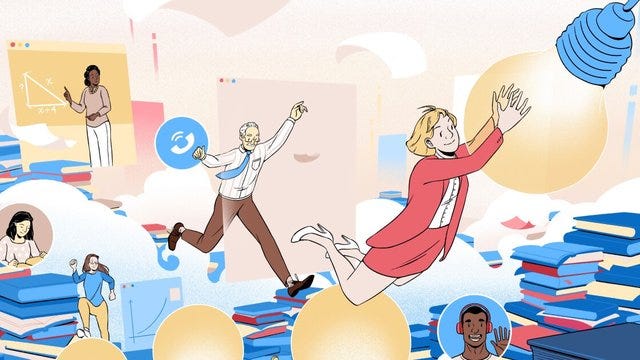Sci-Ed Update 272
Changing minds about human dissection, a new model for brain function, livelier asynch discussions, the vanishing Y chromosome, remembering better, new RSV vax, anatomy coloring app, & more stories!
Remember More, Forget Less
It happens to the best of us: we blank on someone’s name, or forget an important meeting, or bomb a test we thought we’d ace. Today [The Hidden Brain] we talk to cognitive scientist Daniel Willingham about the mysteries of memory: how it works, why it fails us, and how to build memories that stick.
The Y Chromosome Is Vanishing. A New Sex Gene Could Be The Future of Men
The sex of human and other mammal babies is decided by a male-determining gene on the Y chromosome. But the human Y chromosome is degenerating and may disappear in a few million years, leading to our extinction unless we evolve a new sex gene.
The good news is two branches of rodents have already lost their Y chromosome and have lived to tell the tale.
A recent paper in Proceedings of the National Academy of Science shows how the spiny rat has evolved a new male-determining gene.
Read more→ AandP.info/61h
Anaphy 4+
Anaphy is an anatomy color-by-numbers mobile application. It is intended to be an enjoyable way for students, or anyone interested in Anatomy, to learn about the human body. Anaphy combines the stress-reducing properties of coloring with the competency-increasing benefits of using location association and color recognition, with the added advantage of personalized feedback regarding accuracy that paper coloring books do not offer.
Each anatomy-related diagram will have a terms list that will display each structure with its associated color. Once a user colors parts or all of a particular diagram, they can press the "submit" button to receive feedback about the correctness of their drawing. Once the diagram is reviewed, the user will receive a notification within the app denoting the status of their colored diagram, either correct or incorrect.
App users will have coloring diagrams from each human body system to choose from. Users will also have the opportunity to fill out the "contact us" form within the app to request the creation of new anatomy-related diagrams. We will do our best to accommodate these requests and add new coloring diagrams frequently.
Read more→ AandP.info/d4w
Thinking about death: High neural activity is linked to shorter lifespans
Researchers have discovered that higher levels of neural activity cause shorter lifespans, with evidence drawn from studies on roundworms, mice, and humans.
A protein called REST appears to be a key player; REST regulates the expression of several genes, many of which affect neural activity.
The findings offer new targets for further studies on longevity and may even lead to the development of a longevity drug.
Read more→ AandP.info/vs9
Confessions of a Converted Anatomist: Teaching without Anatomical Donors
In the field of anatomy education, the debate over the superiority of learning with or without human donors is decades long and ongoing. Arguments for or against the use of human donors in anatomy education varies for different healthcare disciplines.
Anatomy education in physical therapy programs has been particularly resistant to the trend away from use of human donors. In this personal view, I present my history of anatomy education and how my perspectives on teaching and learning anatomy have changed dramatically throughout my teaching experiences.
The purpose of this article is to support instructors who are creating anatomy courses without donors, inspire those teaching with donors to incorporate other methods of instruction and evaluation, to challenge educators to examine their own biases surrounding anatomy education and provide recommendations for developing an anatomy course without human donors. Included in this article is the perspective of a practicing physical therapist who learned through human dissection and has assisted me in the development and management of the human anatomy course in our physical therapy curriculum.
Kevin Patton comment→ Be sure to click on “Download PDF” at both the very top and bottom of the landing page to read this very thoughtful and thought-provoking opinion from my friend Krista Rompolski.
Read more→ AandP.info/vfs
I’m a Student. You Have No Idea How Much We’re Using ChatGPT.
There’s a remarkable disconnect between how professors and administrators think students use generative AI on written work and how we actually use it. Many assume that if an essay is written with the help of ChatGPT, there will be some sort of evidence — it will have a distinctive “voice,” it won’t make very complex arguments, or it will be written in a way that AI-detection programs will pick up on. Those are dangerous misconceptions. In reality, it’s very easy to use AI to do the lion’s share of the thinking while still submitting work that looks like your own. Once that becomes clear, it follows that massive structural change will be needed if our colleges are going to keep training students to think critically.
The common fear among teachers is that AI is actually writing our essays for us, but that isn’t what happens. You can hand ChatGPT a prompt and ask it for a finished product, but you’ll probably get an essay with a very general claim, middle-school-level sentence structure, and half as many words as you wanted. The more effective, and increasingly popular, strategy is to have the AI walk you through the writing process step by step. You tell the algorithm what your topic is and ask for a central claim, then have it give you an outline to argue this claim. Depending on the topic, you might even be able to have it write each paragraph the outline calls for, one by one, then rewrite them yourself to make them flow better.
Read more→ AandP.info/sgc
A monumental moment: End of international emergency
Today the World Health Organization declared the end of the Public Health Emergency of International Concern (PHEIC). This is a huge moment in our story arc of the fight against COVID-19. Here is what it does and does not mean.
Kevin Patton comment→ This is a plain-English commentary on what last-month’s announcement from WHO really means, from “Your Local Epidemiologist.”
Read more→ AandP.info/2v0
Second RSV Vaccine Lands Approval for Older Adults
The FDA has approved a second respiratory syncytial virus (RSV) vaccineopens in a new tab or window for preventing lower respiratory infections in adults 60 and over, Pfizer announced on Wednesday.
Approval of the unadjuvanted, bivalent RSV prefusion F protein vaccine (Abrysvo) follows an endorsement in Marchopens in a new tab or window from FDA's Vaccines and Related Biological Products Advisory Committee (VRBPAC). Advisors voted 7-4 in support of the vaccine's efficacy and safety data, which were primarily derived from the RENOIR trialopens in a new tab or window.
The phase III study included roughly 37,000 participants, ages 60 and up, who were randomized to either a single intramuscular injection dose of vaccine (120 µg) or placebo. At an interim analysis, vaccine efficacy reached 66.7% against two or more lower respiratory tract RSV symptoms (96.66% CI 28.8-85.8) and 85.7% against three or more symptoms (96.66% CI 32.0-98.7), meeting the co-primary endpoints of the study.
Read more→ AandP.info/ham
Your Brain Is Not a Computer. It Is a Transducer
A new theory of how the brain works — neural transduction theory — might upend everything we know about consciousness and the universe itself.
Over the centuries — completely baffled by where human intelligence comes from — people have used one metaphor after another to ‘explain’ our extraordinary abilities, beginning, of course, with the divine metaphor millennia ago and progressing – and I use that word hesitatingly — to the current information-processing metaphor. I am proposing now that we abandon the metaphors and begin to consider substantive ideas we can test.
To be clear: I am not offering transduction theory as yet another metaphor. I am suggesting that the brain is truly a bidirectional transducer and that, over time, we will find empirical support for this theory.
Read more→ AandP.info/wa9
Teaching: How to create livelier asynchronous discussions
Discussion boards are now fully integrated into most online courses. Done well, they help students deepen their knowledge and build community. But often online discussions get stuck at the level of sharing information, without analysis or critical thinking, and students dismiss posting replies as meaningless busywork. So, how can instructors make online written discussions more engaging?
Read more→ AandP.info/qlo












